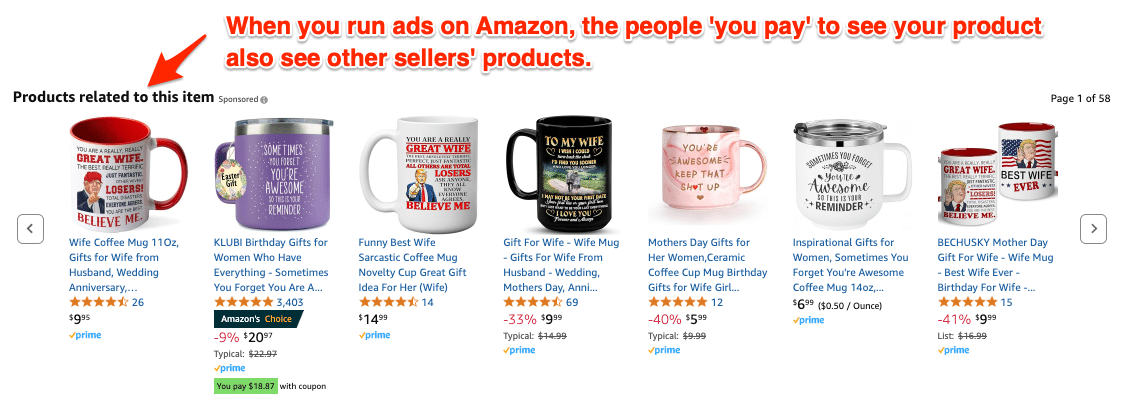
I used to sell print-on-demand products on Amazon and Etsy.
But lately, Amazon has been pretty frustrating, especially with all the trademark issues.
They flag simple words like “Engineer” or “Nerd” as trademark problems…
Some sneaky sellers register these words and get my listings shut down. It’s really annoying and hurts my account.
I tried selling on Etsy twice, but they suspended my account both times for no good reason… So, I haven’t sold on there in years.
Now, I love selling print-on-demand products from my Shopify store. It’s mine, and no one can take it away from me.
With Shopify, I own my email list and can send offers to my subscribers. I can run promotions however I want, which is super flexible.
In my own store, there’s no competition like on Amazon or Etsy. On those platforms, there’s a “Related Products” section that shows other sellers’ stuff.

I enjoy running Amazon Ads, but I hate paying for ads when people buy from someone else.
Building a Shopify store isn’t a quick win. You have to drive traffic, and that takes time. But trust me, it’s worth it in the long run for a store you own.
In this article, I’ll show you how I built passive print-on-demand sales using Shopify and PODtomatic.
Let’s get started.
Meet PODtomatic’s Game-Changing Shopify Integration
PODtomatic was first created to help people upload print-on-demand products to Amazon.
That’s what I needed a few years back. But when I saw how much better Shopify was, I told my team to add a Shopify integration.
Now, PODtomatic’s Shopify integration is a game changer. It uploads tons of products like coffee mugs, tumblers, bracelets, keychains, and ornaments to my Shopify store. These products fit different niches like teachers, engineers, dog lovers, cat moms, and more.
Each product has text-based designs with quotes that match the niche.
For example, a mug for teachers might say, **“Best Teacher Ever.” **PODtomatic’s AI writes the product titles, descriptions, and tags to make them ready for search engines.
I just connect my Shopify store to PODtomatic, and it handles all the heavy lifting.
My store fills up with hundreds or even thousands of products in minutes. I don’t have to upload anything myself or write boring descriptions.
**The goal is to have lots of quality product pages that Google can find. **More pages mean more chances to rank for keywords and get free traffic. It’s like setting up a net to catch buyers searching for special gifts.
The Magic of Shopify Smart Collections
PODtomatic tags every product with details like the niche, such as “Engineer,” and the product type, like “Two Tone Coffee Mug.”

I use these tags in Shopify to create smart collections, like “Coffee Mugs for Engineers” or “Tumblers for Dog Lovers.” These collections automatically grab new products with the right tags.
For instance, if PODtomatic uploads a new “Teacher Coffee Mug,” it goes straight into my “Gifts for Teachers” and “Coffee Mugs for Teachers” collections. I don’t have to add it manually, saving me hours of work each week.
I wrote a script to build the smart collections based on these tags for my Shopify store. I haven’t shared it publicly yet, but with AI today, you can ask tools like ChatGPT, Claude, or Grok to write a piece of code for you. It’s not that hard.
I have a Google Sheet listing all the niches PODtomatic covers, like jobs, pets, hobbies, and more.
If you’re a PODtomatic member, you can use this sheet to plan your smart collections. It’s a goldmine for finding niches to target.
**These collections are the heart of my strategy. **Each one is like a mini landing page for a specific keyword. It has an
tag with this keyword, a description with the same keyword, and a list of products in this collection with that keyword.
They’re designed to rank on Google and attract buyers looking for niche products.
Ranking with pSEO
This strategy is called pSEO, or programmatic SEO.
It’s all about creating tons of pages that target specific, low-competition keywords. My smart collections, like “Coffee Mug for Teacher” or “Keychain for Shiba Inu,” are perfect for this.
My store will have URLs like these:
- https://[mystore].com/coffee-mug-for-engineer
- https://[mystore].com/coffee-mug-for-teacher
- https://[mystore].com/coffee-mug-for-nurse
- https://[mystore].com/coffee-mug-for-lawyer
- https://[mystore].com/bracelet-for-engineer
- https://[mystore].com/bracelet-for-teacher
- https://[mystore].com/bracelet-for-nurse
- https://[mystore].com/bracelet-for-lawyer
These long-tail keywords have less competition on Google.
For example, “Coffee Mug for Engineer” is easier to rank for than just “Engineer Gifts.”
With PODtomatic’s AI writing descriptions, each collection page is full of the right keywords to get noticed by search engines.
I end up with 5,000 smart collections in Shopify (the maximum allowed), each targeting a different keyword.
Over time, these pages rise in Google’s rankings. When someone searches for “coffee mug for teacher,” my collection could pop up and lead them to my store.
The best part? Once these collections are set up, they work on autopilot. New products get added automatically from PODtomatic, and the pages keep bringing in traffic. It’s like having a store that markets itself.
Driving Traffic the Smart Way
Here’s the difficult part: Shopify doesn’t have built-in traffic like Amazon or Etsy. You have to bring people to your store.
That’s the tough part, but I’ve got a system that works.
I look for backlinks to my collection pages. For example, I find Reddit threads or Quora posts where people are asking for gift ideas, like “What’s a good gift for a teacher?” I jump in and share a link to my “Coffee Mug for Teacher” collection.
I also submit my Shopify store to web directories, like niche blogs or gift guides. Each link I get makes my collection pages stronger on Google. It’s like giving them a vote of confidence that helps them rank higher.
Social media is another big win. I post my product pages on Facebook pages and Instagram with product photos and AI-written text. Every post links back to my Shopify store, not Amazon or Etsy. This drives traffic to my site, where I keep all the profits.
It’s a Long-Term Game
Building traffic takes time. It took me months to see steady sales from my Shopify store. But once those collection pages start ranking, the traffic keeps coming without much extra work.
Every backlink and social media post adds up. My store now gets consistent visitors from Google searches, Facebook pages, Instagram, and Reddit threads.
It’s like a snowball that gets bigger over time.
The best part is knowing my store is secure. No more worrying about Amazon’s trademark nonsense or Etsy’s random suspensions.
My Shopify store is mine, and every sale builds my brand.
Take Control Today
My Etsy suspensions and Amazon’s trademark headaches taught me an important lesson: never rely on platforms you can’t control.
With Shopify and PODtomatic, I built a store that runs itself and gets stronger every day. You can do the same.
PODtomatic makes it easy by automating products, descriptions, and tags. Shopify’s smart collections turn those products into traffic-pulling machines.** **
All you need to do is add backlinks and share on social media to get started.
The sooner you begin, the sooner your store will rank and make passive sales.
Sign up for PODtomatic, connect it to Shopify, and start building your own print-on-demand empire today!
—Bank K.
